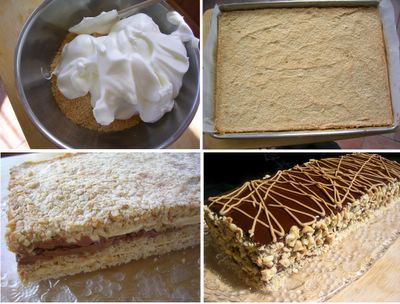Marjolaine

My excuse for making this dessert was to utilize the egg whites left over from my Friday baking extravaganza. In retrospect, it did not seem a frugal idea to use 5 ounces each of hazelnuts and almonds just to save 8 egg whites--neither was it efficient; since buttercream for marjolaine also required egg yolks, I now have 3 more egg whites to save! All the same, I am happy that this gave me an opportunity to refresh my buttercream know-how before it had to be put into more serious use for Amina and Murat's wedding cake. The recipe for the nut meringue pastry (also known as dacquoise) is from Cocolat, but instead of Alice Medrich's buttercream, I turned to my tried and true Neoclassic buttercream recipe from the Cake Bible. The Cocolat recipe called for two cups of buttercream which was not enough to frost in-between the layers and outside the cake, so I had to make extra chocolate ganache to finish it off. Although marjolaine is not easy to put together, it can be planned over a few days so that each step takes a fairly short time. I saw other versions of it using whipped cream and chocolate ganache as filling, and not having to make the buttercream can simplify things considerably. Tastewise, this must be the ultimate dessert for nut-lovers, but for me, it is in the category of desserts for which the look surpasses the taste.

5 oz toasted hazelnuts
5 oz toasted almond
2 tbs flour
1 c sugar
1 c plus 2 tbs egg whites (about 7-8) at room temperature
1/2 tsp cream of tartar
2 to 2 1/2 c buttercream (recipe given seperately)
1 1/2 tbs Sarelle hazelnut spread
1 1/2 tbs almond butter
3 oz chocolate, chopped to pieces
Preheat oven to 325F. Line a 13x18 (or 12x16 or 11x17) inch pan with parchment paper. In a food processor, pulverize the hazelnuts, almonds and 2 tbs flour until a fine meal forms. Add 2/3 c sugar and pulse just to mix. Set aside.
In a large bowl, combine egg whites and cream of tartar. Beat at medium speed until soft peaks form. Turn to high speed and gradually beat in the remaining 1/3 c sugar until stiff but not dry. Fold nut mixture into the egg whites (I did just the opposite as you cab see from the above picture.) Spread meringue evenly in the lined pan. Bake for 30-35 minutes or until golden brown and springy to touch. Cool. This may be prepared and stored at room temperature up to 2 days ahead.
Melt 3 tbs of chocolate and let cool. Stir 1 1/2 tbs of hazelnut spread to 1/4 c buttercream. Set hazelnut buttercream aside. Measure another 1/4 c buttercream and stir 1 1/2 tbs of almond butter to it. Set almond buttercream aside. Finally stir the cooled chocolate to the remaining buttercream and set chocolate buttercream aside.
Run a knife around edges of pan to release meringue. Invert onto waxed paper, remove pan and peel off parchment paper. Cut the pastry into 4 egual strips. Place one strip on the serving plate. Spread with hazelnut buttercream. Place the second pastry strip on top. Spread with 1/2 c chocolate buttercream. Center third strip on top of this, and spread with almond buttercream. Top with fourth strip. Align them so that they are as even as possible. Level top by pressing. If there is time, chill 15-20 minutes.
Trim ragged edges of chilled marjolaine with a serrated knife. Spread remaining chocolate buttercream on sides and top. (Since I did not have enough leftover buttercream, I made ganache with 1/4 c cream and 1.5 oz chocolate and used that to glaze the top) Press chopped nuts on the sides. Decorate the top as desired. (I piped Sarelle hazelnut spread in a criss-cross pattern.) For best flavor and texture, assemble cake at least one day ahead.
Neoclassic Buttercream
I halved the following recipe, but since it was not enough, I will give the recipe for 4 cups as it appears in the Cake Bible. The extra can be frozen for 8 months.
6 large egg yolks
3/4 c sugar
1/2 c corn syrup
2 c softened butter (I actually used 2 tbs less than that)
Have ready a greased 1 c heatproof glass measure nearby. Beat the yolks with an electic mixer until light in color. Meanwhile, combine the sugar and corn syrup in a (preferably nonstick) saucepan and heat stirring constantly, until the sugar dissolves and the syrup comes to a rolling boil. (If you stop short of that, the buttercream will be too thin.) Immediately transfer syrup to the glass measure to stop the cooking.
If using an electric hand-held mixer, beat the syrup into the yolks in a steady stream. (Avoid the beaters, because they will spin it to the sides of the bowl.) Use a spatula to remove the end of the syrup clinging to the glass measure into the mixing bowl. (You will wish you had 2 pairs of hands while doing all this.) Continue beating until completely cool.
Gradually beat in butter. Do not despair if it looks very thin in the beginning. The buttercream will reach the desired consistency toward the end. My buttercream tasted very buttery this time, an indication that the syrup was not enough. To use refrigerated buttercream, wait until it comes to room temperature and rebeat to restore texture.



















<< Home